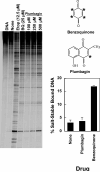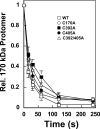Quinone-induced enhancement of DNA cleavage by human topoisomerase IIalpha: adduction of cysteine residues 392 and 405
- PMID: 17298034
- PMCID: PMC2896225
- DOI: 10.1021/bi062017l
Quinone-induced enhancement of DNA cleavage by human topoisomerase IIalpha: adduction of cysteine residues 392 and 405
Abstract
Several quinone-based metabolites of drugs and environmental toxins are potent topoisomerase II poisons. These compounds act by adducting the protein and appear to increase levels of enzyme-DNA cleavage complexes by at least two potentially independent mechanisms. Treatment of topoisomerase IIalpha with quinones inhibits DNA religation and blocks the N-terminal gate of the protein by cross-linking its two protomer subunits. It is not known whether these two effects result from adduction of quinone to the same amino acid residue(s) in topoisomerase IIalpha or whether they are mediated by modification of separate residues. Therefore, this study identified amino acid residues in human topoisomerase IIalpha that are modified by quinones and determined their role in the actions of these compounds as topoisomerase II poisons. Four cysteine residues were identified by mass spectrometry as sites of quinone adduction: Cys170, Cys392, Cys405, and Cys455. Mutations (Cys --> Ala) were individually generated at each position. Only mutations at Cys392 or Cys405 reduced sensitivity ( approximately 50% resistance) to benzoquinone. Top2alphaC392A and top2alphaC405A displayed faster rates ( approximately 2-fold) of DNA religation than wild-type topoisomerase IIalpha in the presence of the quinone. In contrast, as determined by DNA binding, protein clamp closing, and protomer cross-linking experiments, mutations at Cys392 and Cys405 did not affect the ability of benzoquinone to block the N-terminal gate of topoisomerase IIalpha. These findings indicate that adduction of Cys392 and Cys405 is important for the actions of quinones against the enzyme and increases levels of cleavage complexes primarily by inhibiting DNA religation.
Figures







Similar articles
-
Mutation of cysteine residue 455 to alanine in human topoisomerase IIalpha confers hypersensitivity to quinones: enhancing DNA scission by closing the N-terminal protein gate.Chem Res Toxicol. 2007 Jun;20(6):975-81. doi: 10.1021/tx700062t. Epub 2007 May 22. Chem Res Toxicol. 2007. PMID: 17516663 Free PMC article.
-
Polychlorinated biphenyl quinone metabolites poison human topoisomerase IIalpha: altering enzyme function by blocking the N-terminal protein gate.Biochemistry. 2006 Aug 22;45(33):10140-52. doi: 10.1021/bi0524666. Biochemistry. 2006. PMID: 16906772
-
Catalytic core of human topoisomerase IIα: insights into enzyme-DNA interactions and drug mechanism.Biochemistry. 2014 Oct 21;53(41):6595-602. doi: 10.1021/bi5010816. Epub 2014 Oct 10. Biochemistry. 2014. PMID: 25280269 Free PMC article.
-
Two-Mechanism Model for the Interaction of Etoposide Quinone with Topoisomerase IIα.Chem Res Toxicol. 2016 Sep 19;29(9):1541-8. doi: 10.1021/acs.chemrestox.6b00209. Epub 2016 Aug 31. Chem Res Toxicol. 2016. PMID: 27533850
-
Recent advances in the development of catalytic inhibitors of human DNA topoisomerase IIα as novel anticancer agents.Curr Med Chem. 2013;20(5):694-709. doi: 10.2174/092986713804999402. Curr Med Chem. 2013. PMID: 23210851 Review.
Cited by
-
Phytochemicals as Anticancer and Chemopreventive Topoisomerase II Poisons.Phytochem Rev. 2014 Mar 1;13(1):19-35. doi: 10.1007/s11101-013-9291-7. Phytochem Rev. 2014. PMID: 24678287 Free PMC article.
-
The naphthoquinone diospyrin is an inhibitor of DNA gyrase with a novel mechanism of action.J Biol Chem. 2013 Feb 15;288(7):5149-56. doi: 10.1074/jbc.M112.419069. Epub 2012 Dec 28. J Biol Chem. 2013. PMID: 23275348 Free PMC article.
-
The Pigment in Alkaptonuria Relationship to Melanin and Other Coloured Substances: A Review of Metabolism, Composition and Chemical Analysis.JIMD Rep. 2015;24:51-66. doi: 10.1007/8904_2015_453. Epub 2015 Jun 21. JIMD Rep. 2015. PMID: 26093627 Free PMC article.
-
Effects of Secondary Metabolites from the Fungus Septofusidium berolinense on DNA Cleavage Mediated by Human Topoisomerase IIα.Chem Res Toxicol. 2016 Mar 21;29(3):415-20. doi: 10.1021/acs.chemrestox.6b00009. Epub 2016 Feb 26. Chem Res Toxicol. 2016. PMID: 26894873 Free PMC article.
-
Dietary polyphenols as topoisomerase II poisons: B ring and C ring substituents determine the mechanism of enzyme-mediated DNA cleavage enhancement.Chem Res Toxicol. 2008 Jun;21(6):1253-60. doi: 10.1021/tx8000785. Epub 2008 May 8. Chem Res Toxicol. 2008. PMID: 18461976 Free PMC article.
References
-
- Wang JC. DNA Topoisomerases. Annu. Rev. Biochem. 1996;65:635–692. - PubMed
-
- Nitiss JL. Investigating the biological functions of DNA topoisomerases in eukaryotic cells. Biochim. Biophys. Acta. 1998;1400:63–81. - PubMed
-
- Wang JC. Moving one DNA double helix through another by a type II DNA topoismerase: the story of a simple molecular machine. Quart. Rev. Biophys. 1998;31:107–144. - PubMed
-
- Fortune JM, Osheroff N. Topoisomerase II as a target for anticancer drugs: when enzymes stop being nice. Prog. Nucleic Acid. Res. Mol. Biol. 2000;64:221–253. - PubMed
-
- Champoux JJ. DNA topoisomerases: structure, function, and mechanism. Annu. Rev. Biochem. 2001;70:369–413. - PubMed
Publication types
MeSH terms
Substances
Grants and funding
LinkOut - more resources
Full Text Sources

